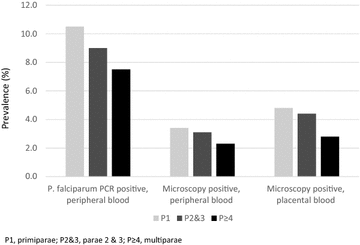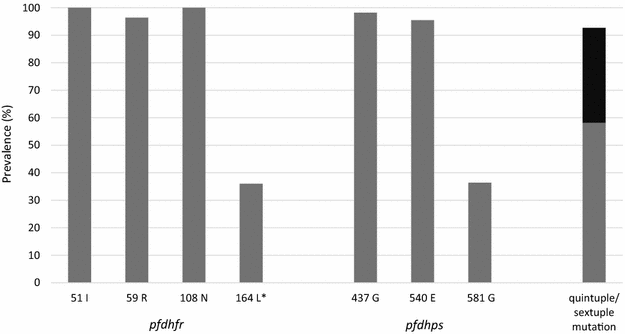Lack of effect of intermittent preventive treatment for malaria in pregnancy and intense drug resistance in western Uganda
- PMID: 26410081
- PMCID: PMC4583758
- DOI: 10.1186/s12936-015-0909-7
Lack of effect of intermittent preventive treatment for malaria in pregnancy and intense drug resistance in western Uganda
Abstract
Background: Intermittent preventive treatment in pregnancy (IPTp) with sulfadoxine-pyrimethamine (SP) is widely implemented in sub-Saharan Africa for the prevention of malaria in pregnancy and adverse birth outcomes. However, in areas of intense SP resistance, the efficacy of IPTp may be compromised.
Methods: A cross-sectional study among 915 delivering women (728 analysable live singleton deliveries) was conducted in Fort Portal, western Uganda, to assess associations of reported IPTp use, Plasmodium falciparum infection, maternal anaemia, low birth weight, and preterm delivery, and to estimate the degree of SP resistance as reflected by pfdhfr/pfdhps mutations.
Results: Plasmodium falciparum infection was detected by PCR in 8.9 % and by microscopy of placental blood samples in 4.0 %. Infection was significantly associated with stillbirth, early neonatal death, anaemia, low birth weight, and pre-term delivery. Eighty percent of the women had taken at least one dose of IPTp, and more than half had taken two doses. As compared to women without chemoprophylaxis against malaria, IPTp had no significant influence on the presence of P. falciparum infection (13.8 vs. 9.6 %, P = 0.31). Nor was it associated with reductions in anaemia, low birth weight or preterm delivery. P. falciparum with intense SP resistance (pfdhfr/pfdhps quintuple or sextuple mutations) were observed in 93 % (pfdhps 581G, 36 %), and the additional high resistance allele pfhdr 164L in 36 %.
Conclusions: In Fort Portal, Uganda, reported use of IPTp with SP does not provide an observable benefit. The molecular markers of P. falciparum indicate high grade SP resistance reaching the threshold set by WHO for the discontinuation of IPTp with SP. Alternative approaches for the prevention of malaria in pregnancy are urgently needed.
Figures
Similar articles
-
Prevalence of Plasmodium falciparum resistance markers to sulfadoxine-pyrimethamine among pregnant women receiving intermittent preventive treatment for malaria in Uganda.Antimicrob Agents Chemother. 2015 Sep;59(9):5475-82. doi: 10.1128/AAC.00507-15. Epub 2015 Jun 29. Antimicrob Agents Chemother. 2015. PMID: 26124154 Free PMC article.
-
Decrease of microscopic Plasmodium falciparum infection prevalence during pregnancy following IPTp-SP implementation in urban cities of Gabon.Trans R Soc Trop Med Hyg. 2016 Jun;110(6):333-42. doi: 10.1093/trstmh/trw034. Epub 2016 Jun 6. Trans R Soc Trop Med Hyg. 2016. PMID: 27268713
-
Decline of placental malaria in southern Ghana after the implementation of intermittent preventive treatment in pregnancy.Malar J. 2007 Nov 8;6:144. doi: 10.1186/1475-2875-6-144. Malar J. 2007. PMID: 17996048 Free PMC article.
-
Malaria prevention in pregnancy, birthweight, and neonatal mortality: a meta-analysis of 32 national cross-sectional datasets in Africa.Lancet Infect Dis. 2012 Dec;12(12):942-9. doi: 10.1016/S1473-3099(12)70222-0. Epub 2012 Sep 18. Lancet Infect Dis. 2012. PMID: 22995852 Review.
-
Effect of Plasmodium falciparum sulfadoxine-pyrimethamine resistance on the effectiveness of intermittent preventive therapy for malaria in pregnancy in Africa: a systematic review and meta-analysis.Lancet Infect Dis. 2019 May;19(5):546-556. doi: 10.1016/S1473-3099(18)30732-1. Epub 2019 Mar 25. Lancet Infect Dis. 2019. PMID: 30922818
Cited by
-
Malaria in Pregnancy: What the Obstetric Provider in Nonendemic Areas Needs to Know.Obstet Gynecol Surv. 2019 Sep;74(9):546-556. doi: 10.1097/OGX.0000000000000704. Obstet Gynecol Surv. 2019. PMID: 31830300 Free PMC article. Review.
-
First-in-human clinical trial to assess the safety, tolerability and pharmacokinetics of P218, a novel candidate for malaria chemoprotection.Br J Clin Pharmacol. 2020 Jun;86(6):1113-1124. doi: 10.1111/bcp.14219. Epub 2020 Feb 12. Br J Clin Pharmacol. 2020. PMID: 31925817 Free PMC article. Clinical Trial.
-
Impacts of Antimalarial Drugs on Plasmodium falciparum Drug Resistance Markers, Western Kenya, 2003-2015.Am J Trop Med Hyg. 2018 Mar;98(3):692-699. doi: 10.4269/ajtmh.17-0763. Epub 2018 Jan 18. Am J Trop Med Hyg. 2018. PMID: 29363453 Free PMC article.
-
Artesunate-amodiaquine and artemether-lumefantrine for the treatment of uncomplicated falciparum malaria in Liberia: in vivo efficacy and frequency of molecular markers.Malar J. 2022 Apr 27;21(1):134. doi: 10.1186/s12936-022-04140-7. Malar J. 2022. PMID: 35477399 Free PMC article.
-
Sub-microscopic Plasmodium falciparum parasitaemia, dihydropteroate synthase (dhps) resistance mutations to sulfadoxine-pyrimethamine, transmission intensity and risk of malaria infection in pregnancy in Mount Cameroon Region.Malar J. 2023 Mar 2;22(1):73. doi: 10.1186/s12936-023-04485-7. Malar J. 2023. PMID: 36864514 Free PMC article.
References
-
- van Eijk AM, Hill J, Larsen DA, Webster J, Steketee RW, Eisele TP, et al. Coverage of intermittent preventive treatment and insecticide-treated nets for the control of malaria during pregnancy in sub-Saharan Africa: a synthesis and meta-analysis of national survey data, 2009–11. Lancet Infect Dis. 2013;13:1029–1042. doi: 10.1016/S1473-3099(13)70199-3. - DOI - PubMed
Publication types
MeSH terms
Substances
LinkOut - more resources
Full Text Sources
Other Literature Sources
Research Materials



